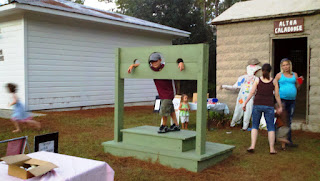Wednesday-Friday, 21-23 September 2011
Panhandle Pioneer Settlement, Blountstown, FL
Boiled peanuts are a big thing in the south. Now I love peanuts! Just about every thing you can do to a peanut suits me just fine. Raw, salted, roasted, peanut butter, Reese's Peanut Butter cups, by the bucket with a pitcher of beer. But this yankee has a hard time getting around boiled peanuts.
So when I learned that Panhandle Pioneer Settlement has a "Peanut Boil" as an event, I was eager to participate, learn, and maybe convince my taste buds that here was a new pleasure for their enjoyment.
Preparations started on Wednesday with two street size trash cans of peanuts donated by a local farmer. We washed the peanuts in the contraption shown in the picture. (I can't remember the name of that thing to save my life.). Washing took most of the day. We washed a couple buckets of peanuts at a time.
Thursday was drying day. Our only activity was to occassionally rake the pile to make sure all the peanuts got exposed to the breeze to dry thoroughly.
Friday we boiled peanuts. The pot was more like a Wok than a kettle. First task was to get a roaring hardwood fire going under the kettle, bring the water to a boil, and add rock salt. Then start dumping in the peanuts. Stoking the fire and stirring with a shovel, kept this mixture cooking for several hours.
The finished product was bagged and sold to the public.
"THE PEANUT BOIL" was a community event sponsored by Panhandle Pioneer Settlement. It ran from afternoon into the evening with games, entertainment, and of course boiled peanuts.
A GOOD TIME WAS HAD BY ALL






















